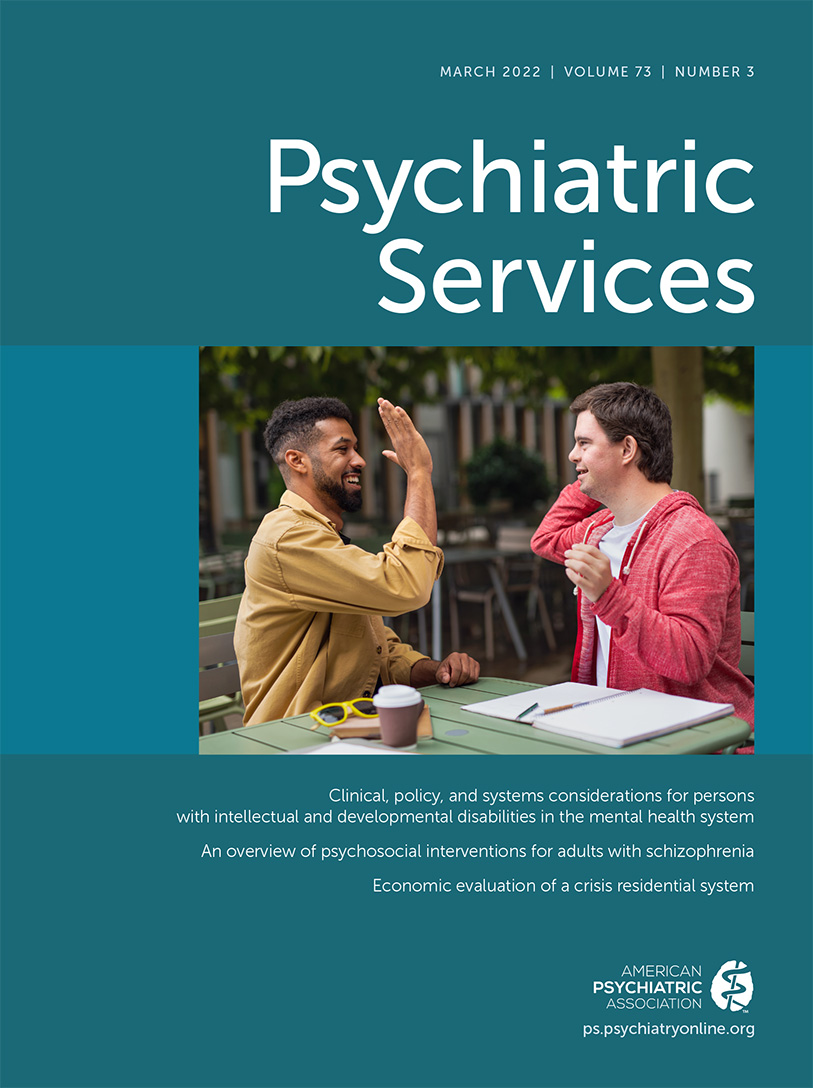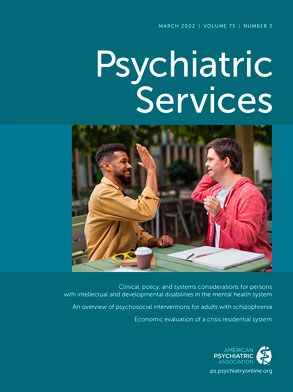Limited English proficiency (LEP) in the absence of trained interpreters can be detrimental to immigrant patients’ mental health care experience. Mental status evaluations performed in patients’ nonprimary languages can lead to distorted assessments and failures to identify disordered thoughts or delusions (
1). LEP has also been associated with underutilization of mental health care services, which can be improved by providing mental health services in patients’ primary languages (
2,
3).
Non-English language services, unlike medications or psychotherapies, are predominantly provided at the facility level rather than at the level of individual mental health practitioners. However, limited information is available on the provision of non-English language services across the more than 14,000 U.S. mental health care facilities. In this study, we used data from the 2018 National Mental Health Services Survey (NMHSS) (
4) to determine the proportion of facilities that provided such services; in addition, we ascertained whether they provided these services through multilingual employee staff, external on-call interpreters, or both. Furthermore, we examined key organizational correlates of provision of non-English language services, including environmental characteristics (i.e., the percentage of non-English speakers in the state population), facility type and ownership, and sources of funding. We also considered operational characteristics, such as the number of patients admitted annually and the number of specialized services provided.
Methods
The NMHSS is an annual, voluntary survey of all known U.S. mental health facilities that gathers data on facility characteristics, including funding sources, licensing, basic treatments provided, and specialized services offered (
4). Of 13,554 eligible facilities, 86.2% (N=11,682) completed the survey. Because the NMHSS is a publicly available data set with no individual patient information, institutional review board approval was not required.
The 2018 NMHSS asked facilities whether they offered mental health treatment services in a language other than English, who provided that service (multilingual staff member, on-call interpreter, or both), and which of 30 languages were specifically provided by multilingual staff members. Spanish was by far the most frequently provided language (N=3,879 of 11,682, 33.2%), followed by French (N=305 of 11,682; 2.6%) and 25 others (see
online supplement).
Facility characteristics recorded by the survey included type of facility (community mental health center [CMHC], hospital, multisetting, outpatient, partial hospitalization, residential, Veterans Health Administration [VHA], or other); funding sources accepted (federal, state, county and local, no government funding, self-pay, private insurance, sliding scale, pro bono, and other); number of total annual admissions (>250 hospital admissions or new outpatients per year); number of specialized services, such as supportive housing, legal assistance, smoking cessation, and others (median=14); age groups treated at the facility; and state where the facility was located. Geographically, high-LEP states were defined as the 10 states (top quintile nationally) with the highest percentage of residents with LEP (California, New York, Texas, New Jersey, Florida, Nevada, Hawaii, Massachusetts, Rhode Island, and New Mexico). Data concerning the percentage of a state’s population with LEP were derived from the U.S. Census Bureau’s American Community Survey 2014–2018 (
5) (for more details on the specialized services and state LEP populations, see the
online supplement).
Analysis proceeded in several steps. First, the facilities with missing data were compared with those with complete data. Then, using only the facilities with complete data, we made comparisons by using bivariate relative risks and multivariate logistic regression of facilities that provided language services and facilities that did not. Then, among the group of facilities providing language services, we compared facilities that employed multilingual staff, that contracted for external on-call interpreters, and that offered both. Because of the large sample sizes, statistical significance was evaluated at the p<0.01 level, and relative risks >1.5 or <0.67 were considered to represent substantial effects (
6).
Using only facilities with complete data, we compared the language facilities versus nonlanguage facilities across 23 characteristics by using bivariate chi-square tests and risk ratios (RRs). Of the 23 variables, 12 met criteria for substantial differences. To address the degree of data correlation within states, we further examined these variables by using a multivariate mixed-effects logistic regression to identify factors independently associated with provision of language services.
In a second analysis, limited to facilities providing language services (N=5,186), we compared those that employed multilingual staff with those that contracted for external on-call interpreters and those that offered both types of service. Using the same 12 variables as the previous model, we applied three multivariate mixed-effects logistic regression models to compare two groups at a time: both versus interpreter only, both versus multilingual staff only, and staff versus interpreter. We conducted all data analysis using R, version 4.0.0, and the “lme4” package for mixed-effects modeling.
Results
Of the 11,682 facilities in the data set, complete data were available for 64.2% (N=7,503). A majority of facilities with complete data provided language services (N=5,186, 69.1%); moreover, there was virtually no difference in language service provision between facilities with complete data and missing data (69.1% [N=5,186 of 7,503] vs. 70.2% [N=2,935 of 4,179], respectively). Facilities with and without complete data differed substantially on only two characteristics: facilities with complete data were less likely to be hospitals (RR=0.66) or VHA facilities (RR=0.43) than were facilities with missing data (see
online supplement).
Of the 7,503 facilities with complete data, 5,186 (69.1%) provided language services. These facilities were more likely to have high patient volume (RR=1.80), to be publicly owned (RR=1.70), to be hospitals (RR=2.33), to be CMHCs (RR=1.93), and to be located in the 10 states with the highest percentage of LEP populations (RR=1.59). They were also more likely to offer a greater than median number of specialized services (RR=1.51) and to provide pro bono care (RR=1.51) (
Table 1). Facilities offering language services were less likely to be VHA medical centers (RR=0.51), residential programs (RR=0.33), or partial hospitalization programs (RR=0.29); they were also less likely to be private for-profit organizations (RR=0.53) or to receive no government funding (federal, state, or local) (RR=0.23) (
Table 1). When these 12 strongly associated characteristics were evaluated together in a multivariate logistic regression, the observed relationships were not substantially altered (see
online supplement). The model’s marginal pseudo R
2 was 0.22.
Multivariate logistic regression was then used to compare three types of facilities that provided language services (N=5,186): those with only multilingual internal employees (N=592, 11.4%), those with only on-call external contract interpreters (N=2,532, 48.8%), and those with both multilingual staff and on-call interpreters (N=2,062, 39.8%) (see
online supplement). Facilities offering only internal multilingual staff were more likely to be private for-profit organizations and were less likely to be publicly owned and to be hospitals, compared with the other two facility types. Facilities with only external on-call interpreters were more likely to be hospitals and were less likely to be located in a state with large LEP populations, compared with the other two groups.
Discussion
Limited literature exists on language service provision by medical organizations—only two studies have examined this issue in general hospitals—and, to our knowledge, our report is the only study that has focused on mental health facilities. Using data from the American Hospital Association and the American Community Survey, Schiaffino and colleagues (
7,
8) found that providing a greater volume of services (i.e., having more beds) and being located in a region with larger LEP populations were prominently associated with providing language services; these results are consistent with our findings for mental health organizations. However, unlike our study, one of those studies found that hospitals owned by private nonprofit organizations had the highest rates of non-English language service provision, with government-owned and private-for-profit organizations both having lower rates of language service provision (
8). This difference may reflect the fact that mental health care facilities, in contrast with general medical hospitals, are more likely to serve low-income populations and to provide services for which language proficiency is especially critical.
The differences in language provision among various types of mental health facilities were another novel finding of our study. Hospitals and CMHCs tended to provide more language services, likely because of their public-oriented mission of serving the surrounding communities. Conversely, residential and partial hospitalization facilities tended not to provide language services, perhaps because these facilities are small and specialized; moreover, patients with LEP receiving care there may get their mental health needs met elsewhere. VHA facilities were less likely to provide language services, probably because of the much lower rates of LEP in the veteran population than in the general population (
9).
No previous studies have described the proportions and characteristics of mental health facilities that provide language services through on-call interpreters, multilingual staff, or both. It is likely that the type of language service provided is determined by the administrators’ evaluation of the cost-effectiveness of hiring, training, and employing in-house staff members versus outsourcing and paying for on-demand services.
Studies of both hospitals and outpatient medical organizations have cited the cost of acquiring interpreter services as one of the most important barriers to providing these services (
10,
11). Currently, few private insurance companies and only 13 state Medicaid programs reimburse interpreter services, meaning that some providers lose money by accommodating patients with LEP who need interpreters (
12,
13). Increasing or establishing funding or insurance coverage for medical interpreters may foster increased provision of language services, especially among private for-profit mental health care facilities with low demand for such services. Further research is needed to establish levels of reimbursement that would be needed to encourage provision of medical interpreters among diverse organizations and regions.
Several methodological limitations of this study deserve comment. First, missing survey data led us to exclude 35.8% (N=4,179 of 11,682) of total responding facilities. However, because comparison of the excluded and included samples showed few differences, we believe that our study’s conclusions still reasonably generalize to U.S. mental health care facilities. Additionally, location data were specific only to the state level. Because LEP population levels can vary across regions within states, examining the association of county-level LEP populations with language service provision would have been a more precise method of examining facilities’ response to their population’s needs.
Furthermore, the NMHSS did not have more specific data about which particular services were offered in which non-English languages; rather, it asked a binary question about whether a facility offers services in non-English languages overall. In addition, data on local legislative mandates and reimbursement policies for medical interpreters were not available in the NMHSS data set and may have a substantial, but unmeasured, impact on language service provision. Last, the NMHSS is not inclusive of all mental health care practiced in the United States because it excluded small practices and correctional facilities where substantial populations may need non-English mental health services (
14).

